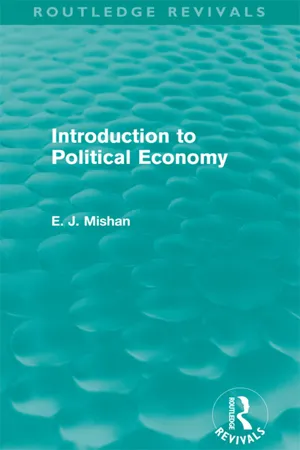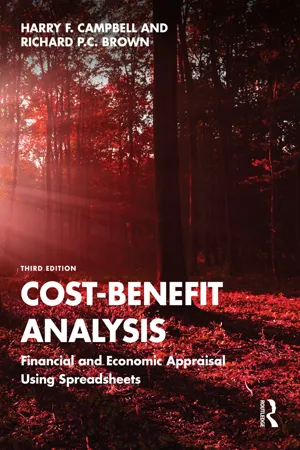Economics
Market Equilibrium Consumer and Producer Surplus
Market equilibrium occurs when the quantity of a good or service supplied by producers equals the quantity demanded by consumers, resulting in an efficient allocation of resources. Consumer surplus represents the difference between what consumers are willing to pay and what they actually pay, while producer surplus is the difference between the price received by producers and the minimum price they are willing to accept.
Written by Perlego with AI-assistance
Related key terms
8 Key excerpts on "Market Equilibrium Consumer and Producer Surplus"
- eBook - ePub
Economics of Tourism and Hospitality
A Micro Approach
- Yong Chen(Author)
- 2021(Publication Date)
- Routledge(Publisher)
Figure 2.3b ).2.3 Economic surplus and market efficiency
2.3.1 Consumer surplus, producer surplus, and social surplus
A consumer whose willingness to pay is higher than the market price obtains consumer surplus, which is the consumer’s willingness to pay less the market price. Thus, the higher the consumer’s willingness to pay, the more the consumer surplus; and the lower the market price, the more the consumer surplus as well, other things being equal. Aggregating the consumer surplus of all consumers in the market we obtain total consumer surplus, denoted by the area beneath the demand curve D and above the equilibrium priceP 0bounded by zero and the equilibrium quantityQ 0(Figure 2.4 ). In fact, consumers do not really claim such surplus because consumers’ willingness to pay is subjective. Consumer surplus can thus be regarded as a kind of gratification that consumers obtain when purchasing at a price lower than what they value. By the same token, a firm whose willingness to sell is lower than the market price obtains producer surplus, which is the market price less the firm’s willingness to sell. Thus, the lower the firm’s willingness to sell, the more the producer surplus; and the higher the market price, the more the producer surplus as well, other things being equal. Aggregating the producer surplus of all firms in the market we obtain total producer surplus, denoted by the area beneath the equilibrium priceP 0and above the supply curve S bounded also by zero and the equilibrium quantityQ 0(Figure 2.4 - eBook - ePub
Microeconomic Foundations I
Choice and Competitive Markets
- David Kreps(Author)
- 2012(Publication Date)
- Princeton University Press(Publisher)
Chapter TwelveProducer and Consumer Surplus
Most courses in microeconomics at some point engage in policy evaluation: What happens if the government taxes or subsidizes the sale of some good? What happens if a price ceiling or a price floor is established? What if imports into a particular domestic market are capped at some level?The discussion of “what happens?” can begin and end with an analysis of changes in prices and quantities. But when it comes to evaluation, one typically seeks dollar-denominated measures of the impact such policies have on firms inside the industry and on consumers of the specific product. The concepts of producer and consumer surplus appear at this point; the former is advanced as a dollar-denominated measure of the impact the policy has on producers; the latter is asserted to be a dollar-denominated measure of its impact on consumers. These concepts are defined graphically, by pictures such as Figures 12.1a and b . In this chapter, we explore the foundations of these two concepts.Figure 12.1. Producer and consumer surplus. Intermediate-level textbooks in microeconomics often have the pictures shown here, accompanied by text such as “The shaded region in panel a is producer surplus, a dollar-denominated measure of the value producers obtain from this market. The shaded region in panel b is consumer surplus, a dollar-denominated measure of the value obtained by consumers.” The objective of this chapter is to make these notions as precise as we can.12.1. Producer Surplus
Producer surplus has a relatively simple story, although one with a hidden trap. The story concerns the market for a particular good supplied by a number F of firms. We assume that the firms are all competitive, engaged in profit maximization in the sense and style of Chapter 9 ; Zf will denote the production-possibility set of firm f. We let p ∈ be the vector of all prices, and we will suppose that coordinate indices have been chosen so that i - eBook - ePub
Economics for Investment Decision Makers
Micro, Macro, and International Economics
- Christopher D. Piros, Jerald E. Pinto(Authors)
- 2013(Publication Date)
- Wiley(Publisher)
Exhibit 1-15 , the gain in value experienced by Warren is depicted by the crosshatched trapezoid. Note that the increase in Warren’s value is necessarily less than the loss in Smith’s. Recall that consumer surplus is value minus expenditure. Total consumer surplus is reduced when individuals consume quantities that do not yield equal marginal value to each one. Conversely, when all consumers face the identical price, they will purchase quantities that equate their marginal values across all consumers. Importantly, that behavior maximizes total consumer surplus.A precisely analogous argument can be made to show that when all producers produce quantities such that their marginal costs are equated across all firms, total producer surplus is maximized. The result of this analysis is that when all consumers face the same market equilibrium price and are allowed to buy all they desire at that price, and when all firms face that same price and are allowed to sell as much as they want at that price, the total of consumer and producer surplus (total surplus) is maximized from that market. This result is the beauty of free markets: They maximize society’s net benefit from production and consumption of goods and services.3.13. Market Interference: The Negative Impact on Total Surplus
Sometimes, lawmakers determine that the market price is too high for consumers to pay, so they use their power to impose a ceiling on price below the market equilibrium price. Some examples of ceilings include rent controls (limits on increases in the rent paid for apartments), limits on the prices of medicines, and laws against price gouging after a hurricane (i.e., charging opportunistically high prices for goods such as bottled water or plywood). Certainly, price limits benefit anyone who had been paying the old higher price and can still buy all they want but at the lower ceiling price. However, the story is more complicated than that. Exhibit 1-16 shows a market in which a ceiling price,Pc - E. J. Mishan(Author)
- 2013(Publication Date)
- Routledge(Publisher)
market demand curves only. It is practically impossible to estimate demand curves, and therefore the relevant consumer surpluses, of single individuals.Fortunately, it is the consumer surplus for the market, for society in effect, that the normative economist is trying to capture. Therefore estimates of the market demand curves for particular goods will admirably serve his purpose – which is not to say that there are not statistical difficulties in estimating many such demand curves owing to the paucity of data.After this somewhat leisurely exposition, we can begin to romp along at a brisker pace. Figure 8 shows a market demand curve DD in which the price has fallen from P2 , say $10 per unit x, at which price the amount OQ2 was bought, to Pl , say $8 per unit, at which price the amount OQ1 is bought. A fall in the price of x by $2 implies an increase in the welfare of buyers of x; at least, it does so if no other goods prices rise, which we may assume in a partial context. The measure of the gain in social welfare from this fall in price is the consumer surplus as measured by the shaded area between the two horizontal price-lines from P2 and P1 respectively.If this is not evident at first, look at it thus: if the price P2 were first established where previously the good x had been unobtainable, the improvement would have been measured as a consumer surplus equal to the triangular area DP2 E. If, instead, the lower price P1 had first been established, the improvement would have been a larger consumer surplus, one equal to the larger triangular area DP1 G. It follows that the difference to consumers of x from having the lower market price P1 rather than P2 is the difference between the two triangular areas, a difference that is measured by the shaded horizontal strip P2 P1 GE. This latter area then is the consumer surplus for a fall in price from P2 to P1 .Figure 8Perhaps you would like to look at it another way, more intuitively obvious to some. The rectangular part of the shaded area P2 P1 FE is the price difference on the original amount of x, OQ2 , bought when the price was P2 . Were consumers restricted to buying this same amount OQ2 of x (even though the price had fallen to P1 ) they would have saved just that much money. For this shaded rectangle P2 P1 FE is equal to the price difference (P2 – P1 ) times OQ2 of x. Thus this area measures the most consumers would pay for this fall in price provided they were allowed to buy no more than OQ2 , this being the amount of x they bought at the old price P2- eBook - ePub
Health Economics For Nurses
Intro Guide
- Stephen Morris(Author)
- 2014(Publication Date)
- Routledge(Publisher)
7. By supply we mean the quantity of a good that producers will wish to offer for sale at a particular price per time period. 8. The quantity supplied of a good is also influenced by a number of variables, such as the price of the good, the prices of other goods and the costs of production. 9. There is, in general, a positive relationship between the price of a good and the quantity supplied of that good. 10. The supply curve may be derived using the Law of Increasing Costs and the assumption that producers wish to maximise their profits. 11. The equilibrium price is the price at which the wishes of consumers and producers coincide.12. If the market price is different from the equilibrium price, then either an upward or downward pressure on price, exerted by market forces and caused by excess demand or excess supply, will cause the market price to tend towards the equilibrium price.13. Changes in the demand and supply curves, caused by changes in the determinants of demand and supply, will cause the equilibrium price to change. 14. There are four basic changes which can occur to the equilibrium price: a rise in demand; a fall in demand; a rise in supply; and a fall in supply. 15. The intuitive reason for using the market framework to address the issue of scarcity is that markets provide a means of allocating resources which is efficient.16. Aiming to maximise their utility, consumers will spend the amount of money which will maximise their well-being, resulting in allocative efficiency. At the same time, producers, seeking to maximise their utility through maximising their profits, will compete for custom by producing goods most highly valued by consumers at least cost, thus behaving in a technically efficient manner.17. Consumers in the market have the knowledge and ability to determine the level of price at which demand equals supply. The dominance of consumer preferences is known as consumer sovereignty, and is a necessary condition for the market to allocate resources efficiently. - eBook - ePub
- Neva Goodwin, Jonathan M. Harris, Julie A. Nelson, Pratistha Joshi Rajkarnikar, Brian Roach, Mariano Torras(Authors)
- 2018(Publication Date)
- Routledge(Publisher)
If the labor market in this hypothetical example were allowed to reach equilibrium, the market-clearing wage rate would be $6.00 per hour and employment would be 2 million workers. But the minimum wage of $7.25/hour prevents market forces from pushing the wage rate any lower than $7.25/hour. The minimum wage is called a price floor because it prevents the wage rate from moving lower, toward equilibrium. Note that if the minimum wage were set below the equilibrium wage, say at $5.00/hour, it would have no effect on the market price.■ Figure 5.11 Welfare Analysis of a Price FloorAt $7.25/hour, the graph tells us that the supply of labor is 2.4 million workers and the demand for labor is 1.7 million workers. Although an equilibrium quantity is determined by the interaction of supply and demand, in the case of a price floor, the market quantity is determined only by the demand curve. In other words, the situation of surplus (excess supply) cannot be eliminated with a price decline, so demand limits the amount that is sold. Thus the presence of the minimum wage, relative to the equilibrium outcome, reduces employment from 2 million to 1.7 million. (Again, these are only hypothetical numbers.)What does this price floor mean in terms of social welfare? Presumably, a minimum wage law is intended to benefit workers, rather than employers. In a labor market, producer surplus represents the social welfare benefits to workers—they are the suppliers. Remember that producer surplus is the area above the supply curve and below the price, up to the quantity sold. We see in Figure 5.11 that if the market were allowed to reach equilibrium (a wage rate of $6.00/hour), consumer surplus would be areas (A + B + C) and producer surplus would be areas (D + E). Total social welfare would be the sum of both surpluses, or (A + B + C + D + E).But with the minimum wage set at $7.25 producer surplus becomes areas (B + D). Without the minimum wage, producer surplus was (D + E). The way the graph is drawn, it appears that producer surplus has increased (i.e., area B, which has been gained, is larger than area E, which has been lost). However, this is not necessarily always the case. To test this, try to draw a market graph in which a price floor decreases producer surplus. (Hint: Make the price floor even further above the equilibrium price.) - eBook - ePub
Cost-Benefit Analysis
Financial and Economic Appraisal Using Spreadsheets
- Harry F. Campbell, Richard P.C. Brown(Authors)
- 2022(Publication Date)
- Routledge(Publisher)
with-and-without comparison conducted in the Efficiency Analysis. In both cases a positive value indicates a more productive use of inputs.We now turn to consumer and producer surplus changes associated with the quantity of the output or input traded in the world without the project. As noted above, a fall in output price will benefit the consumers of the original quantity of the good traded, but it will also be to the detriment of the firms supplying the good. Similarly, a rise in input price, such as an increase in the wage, will benefit the suppliers of the original quantity of the input, but will similarly be to the detriment of the firms employing the input and may result in consumers paying higher prices for output These effects are pecuniary effects, as discussed in Section 7.2, and they net out of the Efficiency Analysis. If they are included in the Referent Group Analysis, it is likely to be in the category described by Area C in Table 6.1 (net Referent Group benefits not measured by market prices), given the localised nature of the project’s effects as discussed above. Whether they are relevant to the decision about the project is a matter for the decision-maker, who may not be interested in changes in the distribution of surplus among consumers, labour and firms, especially given that most households represent more than one of these categories of economic agents, but if they are included, and these agents are all members of the Referent Group, they are entered twice in the Referent Group Analysis, once as a benefit and once as a cost, so that they cancel out in the measure of overall project effects, thereby preserving the adding-up property of the cost-benefit model.Suppose now that the output of a project, such as an improvement to a public road leading to a national park, is not marketed. As we saw from Figure 7.1 , the project benefit takes the form of an increase in consumer surplus accruing to users of the park. As in the case of changes in consumer and producer surplus induced by changes in market prices and associated with project output or inputs, this form of net benefit is not measured by the Market Analysis. In the case of improved access to the national park, the change in surplus is included in area C or D in Table 6.1 , depending on whether or not the consumers are members of the Referent Group. In contrast to the case of a marketed output, surplus accruing to consumers of the without quantity of the service (Area P0 ABP1 in Figure 7.1 - eBook - ePub
- Lynne Pepall, Peter Antonioni, Manzur Rashid(Authors)
- 2016(Publication Date)
- For Dummies(Publisher)
These, in turn, are things that economists hope capture the concept of well-being or utility (see Chapters 2 and 4 – 6 for a fuller discussion of utility). When economists talk about maximizing welfare, they’re relating the concept of utility to groups of economic decision-makers — whether producers, consumers, or society as a whole. Economics uses more than one type of definition of welfare — depending on whether we’re talking about a partial or a general equilibrium model: Partial equilibrium model: In this context, welfare is the sum of the areas bounded by the supply and demand curves in the market for that particular good — the consumer surplus and the producer surplus. General equilibrium model: In this context, welfare means social welfare, the aggregate level of utility across all individuals in the economy. Therefore, seeking the highest level of welfare means making the aggregate level of utility as high as possible. Meeting two social welfare functions Economists consider the issue of equity through the lens of a social welfare function. This function is often described by a curve drawn in a way to reflect different valuations among individuals in the society for different degrees of equity in distributing goods and services. These different degrees in turn tend to be drawn from the standpoints of ethical philosophies
Learn about this page
Index pages curate the most relevant extracts from our library of academic textbooks. They’ve been created using an in-house natural language model (NLM), each adding context and meaning to key research topics.







